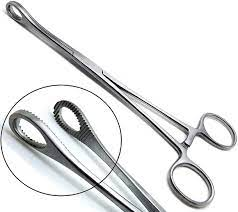
|
Sr. No. |
Name of Surgical Instruments |
Use in Medical Procedures |
|
1 |
Scalpel |
Incisions and precise cutting |
|
2 |
Forceps |
Grasping, holding, and manipulating tissues |
|
3 |
Retractor |
Holding incisions open and exposing the area |
|
4 |
Scissors |
Cutting tissues and sutures |
|
5 |
Needle Holder |
Holding and passing sutures through tissues |
|
6 |
Tissue Forceps |
Holding and manipulating delicate tissues |
|
7 |
Trocar |
Creating access points for minimally invasive surgery |
|
8 |
Bone Saw |
Cutting through bones during orthopedic procedures |
|
9 |
Rongeur |
Removing bone fragments and tissue |
|
10 |
Surgical Drill |
Drilling holes in bones |
|
11 |
Speculum |
Examining and accessing body cavities |
|
12 |
Curette |
Scraping or scooping tissues |
|
13 |
Retractor |
Exposing surgical field and organs |
|
14 |
Clip Applier |
Applying clips to close blood vessels |
|
15 |
Stapler |
Closing and sealing tissue incisions |
|
16 |
Electrocautery |
Cutting, coagulating, and sealing blood vessels |
|
17 |
Suture |
Stitching incisions and wound closure |
|
18 |
Bulldog Clamp |
Temporarily occluding blood vessels |
|
19 |
Nasal Speculum |
Examining nasal passages |
|
20 |
Anoscope |
Examining the anus and rectum |
|
21 |
Tenotomy Scissors |
Cutting tendons |
|
22 |
Biopsy Punch |
Obtaining tissue samples for examination |
|
23 |
Rib Spreader |
Opening the ribcage for thoracic surgeries |
|
24 |
Grafting Knife |
Preparing grafts for transplantation |
|
25 |
Retinal Scissors |
Cutting delicate structures in eye surgeries |
|
26 |
Ligature Carrier |
Placing and tying ligatures |
|
27 |
Spinal Needle |
Administering anesthesia or withdrawing fluid |
|
28 |
Endoscope |
Visualizing internal structures |
|
29 |
Gastroscope |
Examining the gastrointestinal tract |
|
30 |
Cannula |
Inserting and draining fluids |
|
31 |
Ophthalmoscope |
Examining the interior of the eye |
|
32 |
Tonsillectomy |
Removing tonsils |
|
33 |
Cystoscope |
Examining the urinary bladder |
|
34 |
Bone Clamp |
Holding bone fragments in place |
|
35 |
Trocar |
Draining fluid or creating access points |
|
36 |
Rib Shear |
Cutting ribs during thoracic surgeries |
|
37 |
Babcock Forceps |
Grasping and manipulating delicate tissues |
|
38 |
Abdominal Retractor |
Exposing abdominal cavity |
|
39 |
Vascular Clamp |
Occluding blood vessels during surgery |
|
40 |
Bronchoscope |
Examining the bronchial passages |
|
41 |
Dermal Curette |
Removing skin lesions |
|
42 |
Catheter |
Inserting and draining fluids |
|
43 |
Myringotomy Knife |
Making incisions in the eardrum for drainage |
|
44 |
Uterine Sound |
Measuring the depth of the uterus |
|
45 |
Thoracic Trocar |
Inserting chest tubes |
|
46 |
Episiotomy Scissors |
Making incisions during childbirth |
|
47 |
Tissue Scissors |
Cutting and dissecting delicate tissues |
|
48 |
Vein Stripper |
Removing varicose veins |
|
49 |
Hernia Clamp |
Repairing hernias |
|
50 |
Endocervical Curette |
Scraping the cervical canal |
|
51 |
Bone Chisel |
Cutting or shaping bones during orthopedic procedures |
|
52 |
Hemostat |
Controlling bleeding during surgery |
|
53 |
Suture Passer |
Passing sutures through tissues or anatomical
structures |
|
54 |
Dermatomes |
Precisely cutting thin slices of skin for grafting
procedures |















